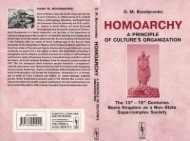L. Fituni, I. Abramova Resource Potential of Africa and Russia's ...
L. Fituni, I. Abramova Resource Potential of Africa and Russia's ...
L. Fituni, I. Abramova Resource Potential of Africa and Russia's ...
You also want an ePaper? Increase the reach of your titles
YUMPU automatically turns print PDFs into web optimized ePapers that Google loves.
duce the gap between the raw material requirements <strong>of</strong> the nuclear<br />
power industry <strong>and</strong> their supply; however, the natural uranium<br />
shortage in the market will persist. 15<br />
In the last decade, the burgeoning nuclear power industry has<br />
given rise to a steady increase in world uranium consumption; in<br />
2005 it reached 69 thous<strong>and</strong> tons with its production being 40 thous<strong>and</strong><br />
tons only. A shortage <strong>of</strong> about 30 thous<strong>and</strong> tons is covered by<br />
stock resources. Russia faces similar problems as other countries all<br />
over the world: uranium dem<strong>and</strong> considerably exceeding its production;<br />
a rapid depletion <strong>of</strong> natural uranium stocks that are enough for<br />
less than 10–15 years, <strong>and</strong> lack <strong>of</strong> sufficient geological reserves<br />
prepared for commercial development. In this connection the RF<br />
Government made a decision to substantially facilitate the development<br />
<strong>of</strong> the nuclear power industry <strong>and</strong> accelerate the development<br />
<strong>of</strong> its mineral resource base.<br />
At present, Russia’s total explored uranium reserves <strong>of</strong><br />
1+2 categories are 656 thous<strong>and</strong> tons with the lowest 2 category<br />
dominating (67.7%). However, the quality <strong>of</strong> the reserves<br />
leaves much to be desired because <strong>of</strong> a low uranium grade <strong>of</strong> ore<br />
<strong>and</strong> insufficient infrastructures in ore districts. Development <strong>of</strong><br />
about 600 thous<strong>and</strong> tons <strong>of</strong> the reserves may be considered practicable<br />
in the near future. Besides, there are expected uranium resources,<br />
which are also considerable <strong>and</strong> are estimated at about 830 thous<strong>and</strong><br />
tons under the most reliable 1+2 categories.<br />
In Russia, the region <strong>of</strong> Eastern Siberia <strong>and</strong> the Far East st<strong>and</strong>s<br />
out for the total mineral resource potential; it accounts for 93% <strong>of</strong><br />
explored uranium reserves <strong>and</strong> 56% <strong>of</strong> total uranium expected resources.<br />
A number <strong>of</strong> districts concentrating main uranium reserves<br />
<strong>and</strong> resources are located just within this region.<br />
The Streltsovsky district, Chita Oblast, contains 15 U-Mo deposits.<br />
They are mined by the Priargunsky Production Mining/Chemical<br />
Association. Total uranium reserves <strong>of</strong> the district<br />
are 22% <strong>of</strong> its total reserves in the Russian Federation. The Vitim<br />
district, Republic <strong>of</strong> Buryatia, unites 8 uranium deposits in erosional<br />
paleovalleys. The district with reserves accounting for 8%<br />
<strong>of</strong> Russia’s total uranium reserves is developed by Khiagda OJSC.<br />
76







